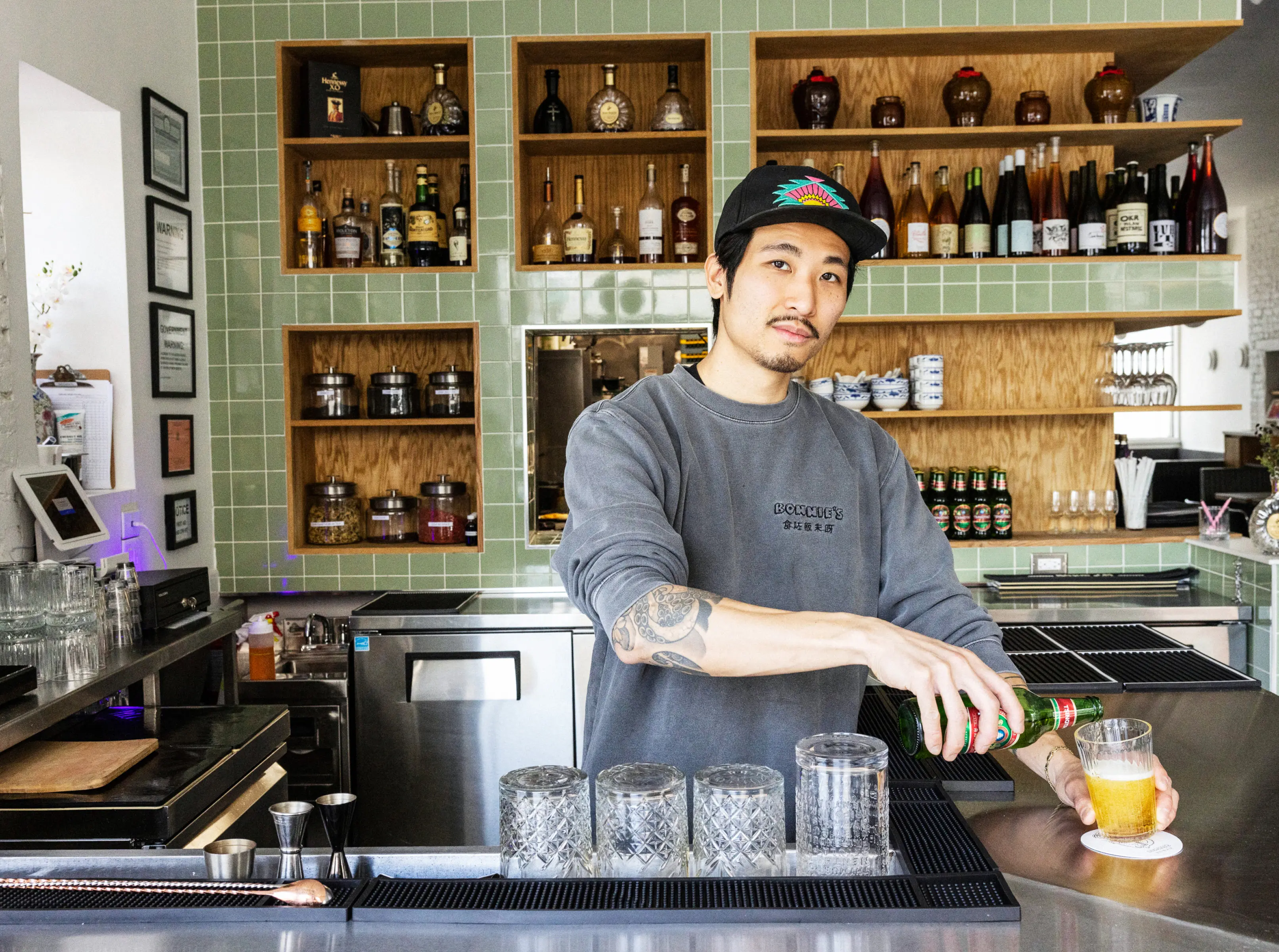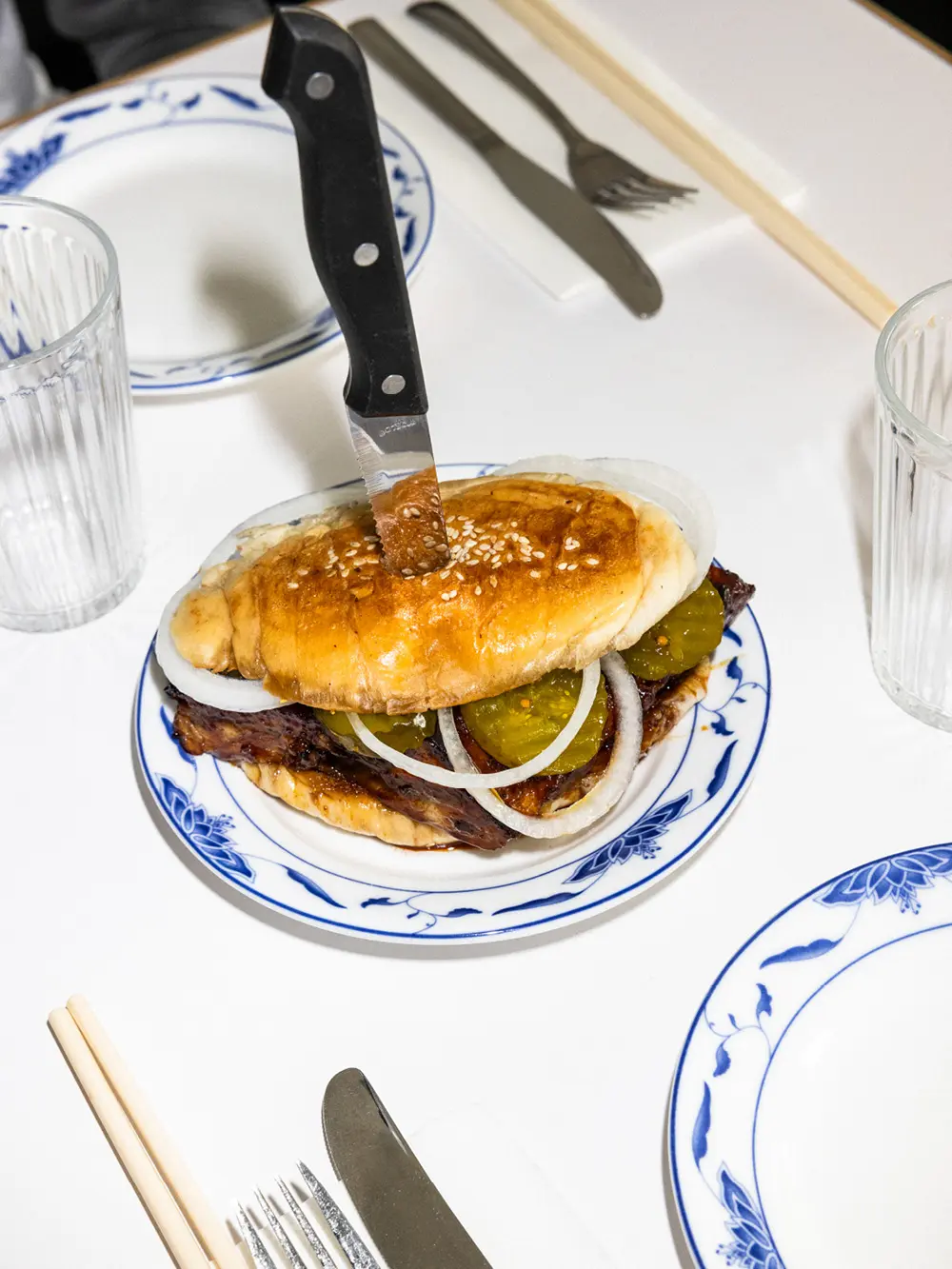Table Talk
Calvin Eng
April 15, 2022
Calvin Eng is setting his own course in Chinese cuisine. Writer Chadner Navarro catches up with the chef about his wildly popular restaurant Bonnie’s—now with a waitlist of 1,500-long and counting.
At the newly opened Williamsburg restaurant Bonnie’s, Calvin Eng is bringing his story to the table. “Everything I know about Cantonese food specifically, I learned from my mom,” says the 27-year-old chef. “That’s why I named the restaurant after her.” Born in Bay Ridge, Eng grew up spending days in the kitchen with his family’s matriarchs as they prepared sprawling meals—watching them fuss over dumplings for wonton soup and helping stuff fish. It was those at-home moments that inspired Eng to pursue a career in food.
Before opening Bonnie’s in 2021, Eng got his start working in notable New York kitchens. First, at the fast-casual dim sum spot Nom Wah Nolita, followed by the Taiwanese-American restaurant Win Son, where he became chef de cuisine and the idea for a solo project slowly took root. His time spent in professional kitchens helped inform the direction he decided to take with Bonnie’s—an unpretentious neighborhood joint with old-school Brooklyn flavor—but it was his family’s kitchen during his childhood days that became the foundation for his menu. “I didn’t even realize this until I sat down writing menu notes,” says Eng, adding that every dish has a story with a personal connection. “I believe great food always has a story behind it.”

QFor those of us who may not know, how would you describe Cantonese food?
AMost people are not familiar with the regional differences in Chinese food, but Cantonese is seafood-forward, minimal ingredients, very technical in allowing the main ingredients to shine without overdoing anything. It’s not a lot of acid or heat, but there are a lot of umami flavors.
QTell us more about your mom’s impact on your cooking.
AMy mom cooked every meal growing up. We had dinner together as a family every night. And I just hung around the kitchen all the time. Being allowed to get involved with cooking, which a lot of kids may have considered a chore, was actually a lot of fun for me. And at Bonnie’s, the steamed egg custard is my mom’s recipe including her ratio of liquid to egg. What we serve is her way of doing that dish. And our stuffed fish is something that we used to make as a family. My mom, my aunt, and myself—we made that dish once or twice a year.
QHow would you describe the work you’re doing at Bonnie’s?
AI always tell people that Bonnie’s is Cantonese-American. The flavors, ideas, and philosophies behind the menu are Cantonese—the ingredients represent a Cantonese pantry. But I was born and raised in New York so I’m going to take influences from all over the world because I’m from this melting pot. This is cheesy, but I always say that nostalgia is my favorite ingredient. When you eat something, and the flavors bring you back to a certain time of your life or to a certain memory, that’s what I love about eating. And even if you didn’t grow up Cantonese, you can still find those connections in our food. I’ve had guests tell me that our fish reminds them of gefilte fish.
QWhat’s a dish on the menu that best represents your philosophy?
AThe wun tun en brodo is a play on the Italian tortellini in brodo. I ordered a bowl of that in Bologna, and without tasting it, it reminded me so much of wonton soup. The idea clicked that if I could make teeny-tiny baby wontons stuffed with fish and shrimp and put them in a classic Chinese superior broth and then add parmesan rind you’re going to get that umami quality that I love. And then we add orange zest, but in Cantonese cooking, we might use dried tangerine peels.

"I want to be part of the next phase of Cantonese food because places are closing and people are retiring. So I do feel a responsibility to preserve these ideas while also helping evolve them by cooking what I know."
QSome of your dishes have gone viral, like the char siu McRib. How did you come up with that?
AThis was never supposed to be a viral concept. But when I was doing research and development for this menu, I knew I needed a sandwich. Char siu is a Cantonese staple so I was thinking a lot about it when I saw an ad for the McRib. So I combined the two. We focused on using Cantonese techniques to make that rib super tender, falling off the bone. It’s glazed in a char siu sauce, served in a sesame milk bun. So this dish incorporates a lot of ideas: dim sum, Chinese bakery, roast meat shop, and American fast food—it’s playful, nostalgic.
QWhat were the more challenging parts of developing this menu?
AWe’re in Brooklyn. People here love salads. But Chinese people don’t eat raw vegetables. So making a salad that still fits our concept was tough. We experimented a lot, and some of the dishes were just disgusting. I was trying to Bonnie-fy something, forcing it to work, and it wasn’t happening, because salad was just not what we eat. But the one that worked—it’s light, naturally vegan, it’s on the menu now—people love it.
QYou mentioned that most people don’t really understand what Cantonese food is. How does Bonnie’s help with that?
AIt’s important to have an educational component to food, regardless of cuisine. I want to be part of the next phase of Cantonese food because places are closing and people are retiring. The younger generation isn’t taking over. So I do feel a responsibility to preserve these ideas while also helping evolve them by cooking what I know.
QWhat's it like to launch a project during a global pandemic?
ASourcing ingredients is extremely difficult right now. I'm very specific about the brands of products I use to cook with, especially ingredients from Hong Kong and China. My mom is the same way which is why I'm so loyal to certain soy sauce brands or salted radish brands. But we were very fortunate with staffing, because while I was able to rely on previous relationships, so many people reached out because they were interested in being a part of this team.
QWhat was in your head when you dreamt up the place? Because it’s taken on this boisterous, party atmosphere.
AI wanted a fun neighborhood restaurant. We’re on a residential street. There are no other businesses around. So it was supposed to be a neighborhood joint. It turned into something else because you can’t really plan for what a restaurant is going to be. The guests determine what it becomes. And I’m fine with it. The guests want to have a good time. They want to celebrate. And when they’re here, they want to turn their experience into a special occasion. And that’s what Bonnie’s has become.
Chadner Navarro is a Manila-born, New Jersey-based writer specializing in travel and food. He’s written for Travel + Leisure, Conde Nast Traveler, Barron’s, and Wine Enthusiast.
Editor: Dickson Wong
Photography: Jonathan Hökklo
